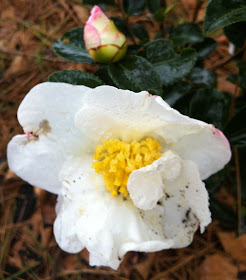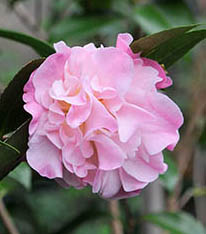please subscribe by email on that site if you wish.
This week in metro-Atlanta, Crabapple LanscapEXPERTS suggest you pay attention to the weather forecasts! In meteorologist lingo, “the Jet Stream is blasting south, bringing frigid air masses from polar regions” and this is called an “advective freeze". We know that windy cold with a sudden plunge in temperatures, sometimes prolonged over several days, makes plant protection difficult. Remember, healthy, hardy landscape plants on the properties you manage will be unaffected by this cold snap.
How To Best Protect Landscape Plants
Tip 1. Add mulch to protect newly planted roots. Apply organic mulch anytime to insulate shallow roots by reducing temperature fluctuations. Most woody ornamentals and perennials are root hardy, so use a layer of mulch to protect the crown and the root zone despite the fact that foliage may die back to ground level. Evergreens and newly transplanted plants especially benefit from a thick layer of mulch around their bases insulating the soil and allowing them to take up moisture despite periods of cold weather and avoid dehydration.Don't let "mulch volcanoes" touch the trunks though.
Tip 2. Drape burlap, canvas, old quilts or sheets, large cardboard boxes, or floating row cover fabric over plants for the duration of the coldest temperatures for three reasons:
a. to slow wind movement;
b. to protect from frost; and
c. to shade from early morning sunshine- devastating to frozen leaves
NEVER use plastic to cover plants; not clear plastic, not black plastic, and not white plastic. Plastic traps solar radiation and causes a buildup of moisture underneath. If plastic is not removed at dawn (and who is going to do that?) the sun’s rays cause heat build-up and frozen plant tissue bake inside the tent.
Tip 3. Use windbreaks like fences, walls, tree canopies or the sides of buildings to protect container plants that can’t come inside. Coverings include frost cloth, sheets and quilts, plastic, cardboard panels or large cardboard boxes, and lean-tos propped against the wall.
Tip 4. Consider building a quick-frame (cold frame) to provide additional protection for favorite or newly transplanted ornamentals. Drive stakes into the ground around the plant(s) then drape canvas over the stakes, making sure it reaches to the ground. This provides air flow and ensures the cover does not have direct contact with the leaves, since touching can injure the foliage.
Tip 5. Water the soil ahead of the freeze or when there is a slight break in the freezing temperatures to maintain soil moisture, but do not over water. Watering melts frozen soil or container potting mixes and lets plants become re-hydrated.
7 Tip 6. Home gardeners: DO NOT try to use water as cold protection! Commercial agricultural enterprises sometimes use water from a sprinkler system to coat strawberries or citrus fruits. The idea is to keep the leaf surface temperatures near 32°F (0°C) because sprinkling utilizes latent heat released when water changes from a liquid to a solid state. But sprinkling must begin as freezing temperatures are reached and continue until thawing is completed. Water must be evenly distributed and supplied in ample quantity to maintain a film of liquid water on the foliage surfaces, possibly for days.
Although commercial farms uses sprinkling for cold protection, residential sprinkler systems do not have the flow volume to protect plants this way. Too much water can cause disease, plus the sprinkler itself can freeze up. As a result, cold damage to plants from inadequate amounts of irrigation water may worse than if nothing was done at all.
Tip 7. Move container plants to a shaded location to avoid morning sun hitting them. Lift pots and containers and place on lumber or 'pot feet' to prevent waterlogging. Insulate above-ground pots with a layer of bubble wrap or hessian to prevent them freezing and cracking and ensure plant rootballs stay healthy.
The Last 3 Tips are for those of us guilty of stretching the Climate Zone envelope. These plants shouldn't actually survive, but just maybe . . .
Tip 8. Blankets do not provide “warmth” unless an incandescent light bulb or a string of Christmas lights is added inside the covering. Choose extension cords labeled for outdoor use. (New LED lights won’t add heat.) This is sometimes used as a temporary measure for a day or two.
Tip 9. Happen to have a cool greenhouse handy? Lucky! Tender plants grown in pots can be moved inside during bad weather. Or take cuttings of those that cannot be grown in pots and overwinter these in a warm greenhouse or on a windowsill, ready for planting in spring.
Without a greenhouse, move hardy container plants under a protective roof like a deck or porch, and group them together to increase their protection. Move tropicals indoors overnight to avoid temperatures below 35 degrees F. then cart them outside again for the sunny days.
Tip 10. Cover is especially beneficial for borderline tender plants that the gardener just had to give a try. The ever-increasing number of tender plants available may not withstand sustained cold without some form of protection. Hardy Tropicals may fit this description. Recent transplants are good candidates for protection, because they may not had enough time to establish strong root systems.
Crabapple LandscapExperts know that well-cared for, hardy landscape plants will not need any protection at all! Call your Crabapple Rep with any questions at 770-740-9739!





































